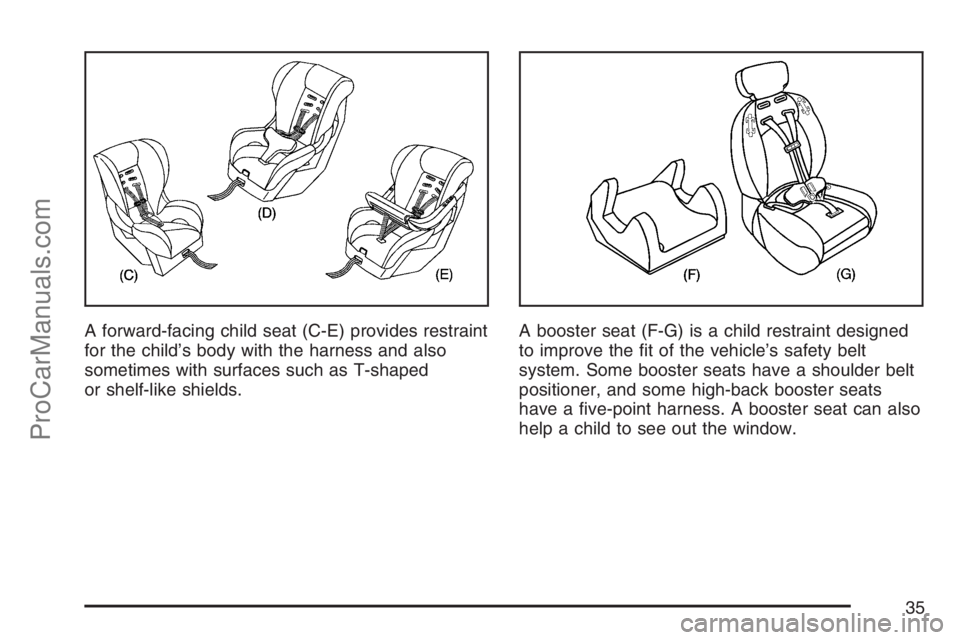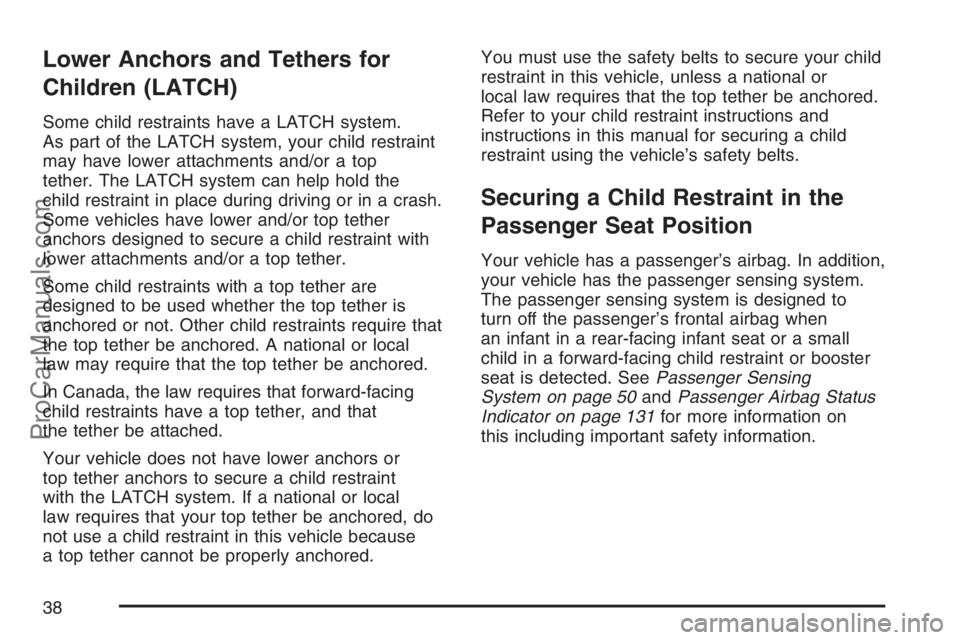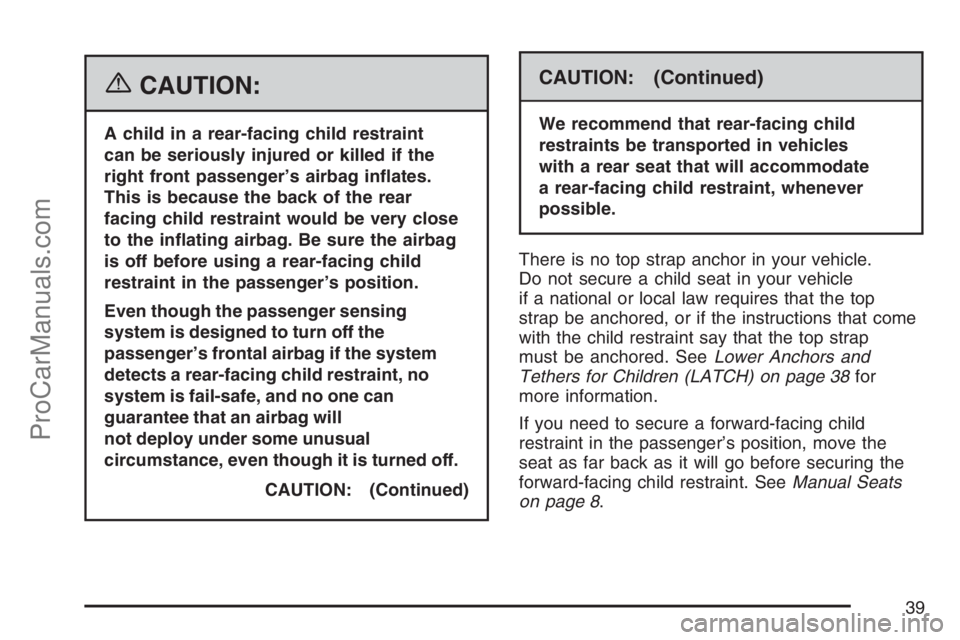2007 SATURN SKY child seat
[x] Cancel search: child seatPage 35 of 384

A forward-facing child seat (C-E) provides restraint
for the child’s body with the harness and also
sometimes with surfaces such as T-shaped
or shelf-like shields.A booster seat (F-G) is a child restraint designed
to improve the �t of the vehicle’s safety belt
system. Some booster seats have a shoulder belt
positioner, and some high-back booster seats
have a �ve-point harness. A booster seat can also
help a child to see out the window.
35
ProCarManuals.com
Page 36 of 384

Q:How Should I Use a Child Restraint?
A:A child restraint system is any device designed
for use in a motor vehicle to restrain, seat,
or position children. A built-in child restraint
system is a permanent part of the motor
vehicle. An add-on child restraint system is a
portable one, which is purchased by the
vehicle’s owner. To help reduce injuries, an
add-on child restraint must be secured in
the vehicle. With built-in or add-on child
restraints, the child has to be secured within
the child restraint.
When choosing an add-on child restraint, be
sure the child restraint is designed to be
used in a vehicle. If it is, it will have a label
saying that it meets federal motor vehicle
safety standards. Then follow the instructions
for the restraint. You may �nd these
instructions on the restraint itself or in a
booklet, or both.
Securing an Add-on Child Restraint
in the Vehicle
{CAUTION:
A child can be seriously injured or killed
in a crash if the child restraint is not
properly secured in the vehicle. Make sure
the child restraint is properly installed in
the vehicle using the vehicle’s safety belt,
following the instructions that came with
that restraint, and also the instructions in
this manual.
To help reduce the chance of injury, the child
restraint must be secured in the vehicle. Child
restraint systems must be secured in vehicle seats
by lap belts or the lap belt portion of a lap-shoulder
belt. A child can be endangered in a crash if the
child restraint is not properly secured in the
vehicle.
36
ProCarManuals.com
Page 38 of 384

Lower Anchors and Tethers for
Children (LATCH)
Some child restraints have a LATCH system.
As part of the LATCH system, your child restraint
may have lower attachments and/or a top
tether. The LATCH system can help hold the
child restraint in place during driving or in a crash.
Some vehicles have lower and/or top tether
anchors designed to secure a child restraint with
lower attachments and/or a top tether.
Some child restraints with a top tether are
designed to be used whether the top tether is
anchored or not. Other child restraints require that
the top tether be anchored. A national or local
law may require that the top tether be anchored.
In Canada, the law requires that forward-facing
child restraints have a top tether, and that
the tether be attached.
Your vehicle does not have lower anchors or
top tether anchors to secure a child restraint
with the LATCH system. If a national or local
law requires that your top tether be anchored, do
not use a child restraint in this vehicle because
a top tether cannot be properly anchored.You must use the safety belts to secure your child
restraint in this vehicle, unless a national or
local law requires that the top tether be anchored.
Refer to your child restraint instructions and
instructions in this manual for securing a child
restraint using the vehicle’s safety belts.
Securing a Child Restraint in the
Passenger Seat Position
Your vehicle has a passenger’s airbag. In addition,
your vehicle has the passenger sensing system.
The passenger sensing system is designed to
turn off the passenger’s frontal airbag when
an infant in a rear-facing infant seat or a small
child in a forward-facing child restraint or booster
seat is detected. SeePassenger Sensing
System on page 50andPassenger Airbag Status
Indicator on page 131for more information on
this including important safety information.
38
ProCarManuals.com
Page 39 of 384

{CAUTION:
A child in a rear-facing child restraint
can be seriously injured or killed if the
right front passenger’s airbag in�ates.
This is because the back of the rear
facing child restraint would be very close
to the in�ating airbag. Be sure the airbag
is off before using a rear-facing child
restraint in the passenger’s position.
Even though the passenger sensing
system is designed to turn off the
passenger’s frontal airbag if the system
detects a rear-facing child restraint, no
system is fail-safe, and no one can
guarantee that an airbag will
not deploy under some unusual
circumstance, even though it is turned off.
CAUTION: (Continued)
CAUTION: (Continued)
We recommend that rear-facing child
restraints be transported in vehicles
with a rear seat that will accommodate
a rear-facing child restraint, whenever
possible.
There is no top strap anchor in your vehicle.
Do not secure a child seat in your vehicle
if a national or local law requires that the top
strap be anchored, or if the instructions that come
with the child restraint say that the top strap
must be anchored. SeeLower Anchors and
Tethers for Children (LATCH) on page 38for
more information.
If you need to secure a forward-facing child
restraint in the passenger’s position, move the
seat as far back as it will go before securing the
forward-facing child restraint. SeeManual Seats
on page 8.
39
ProCarManuals.com
Page 40 of 384

You will be using the lap-shoulder belt to secure
the child restraint in this position. Be sure to follow
the instructions that came with the child restraint.
Secure the child in the child restraint when and as
the instructions say.
1. Your vehicle has a passenger’s frontal airbag.
SeePassenger Sensing System on page 50.
We recommend that rear-facing child
restraints not be transported in your vehicle,
even if the airbag is off. If your child restraint
is forward-facing, move the seat as far
back as it will go before securing the child
restraint in this seat. SeeManual Seats
on page 8.
When the passenger sensing system has
turned off the passenger’s frontal airbag, the
off indicator in the passenger airbag status
indicator should light and stay lit when
the vehicle is started. SeePassenger
Airbag Status Indicator on page 131.
2. Put the child restraint on the seat.3. Pick up the latch plate, and run the lap and
shoulder portions of the vehicle’s safety belt
through or around the restraint. The child
restraint instructions will show you how.
4. Buckle the belt. Make sure the release button
is positioned so you would be able to unbuckle
the safety belt quickly if you ever had to.
40
ProCarManuals.com
Page 42 of 384

7. Push and pull the child restraint in different
directions to be sure it is secure.
8. If the airbag is off, the off indicator on the
instrument panel will be lit and stay lit
when the vehicle is started.
If a child restraint has been installed and the on
indicator is lit, turn the vehicle off. Remove
the child restraint from the vehicle and reinstall
the child restraint.
If, after reinstalling the child restraint and restarting
the vehicle, the on indicator is still lit, check to
make sure that the vehicle’s seatback is not
pressing the child restraint into the seat cushion.
If this happens, slightly recline the vehicle’s
seatback and adjust the seat cushion if possible.A thick layer of additional material such as a
blanket, or aftermarket equipment such as seat
covers, seat heaters and seat massagers, located
between the seat cushion and the child restraint
or small occupant, can affect how the passenger
sensing system operates. Remove any additional
material from the seat cushion before reinstalling
or securing the child restraint and before a
small occupant, including a small adult, sits in
the passenger position.
If the on indicator is still lit, do not install a child
restraint in this vehicle and check with your retailer.
To remove the child restraint, just unbuckle the
vehicle’s safety belt and let it go back all the way.
The safety belt will move freely again and be
ready to work for an adult or larger child
passenger.
42
ProCarManuals.com
Page 50 of 384

Passenger Sensing System
Your vehicle has a passenger sensing system.
The passenger airbag status indicator will be
visible when you turn your ignition key to
RUN or START.
The words ON and OFF or the symbol for on
and off, will be visible on the instrument panel
during the system check. When the system check
is complete, either the word ON or the word
OFF, or the symbol for on or the symbol for off will
be visible. SeePassenger Airbag Status Indicator
on page 131.The passenger sensing system will turn off the
passenger’s frontal airbag under certain conditions.
The driver’s airbag is not part of the passenger
sensing system.
The passenger sensing system works with
sensors that are part of the passenger’s seat.
The sensors are designed to detect the presence
of a properly-seated occupant and determine if
the passenger’s frontal airbag should be enabled
(may in�ate) or not.
Accident statistics show that children are safer
if they are restrained in the rear rather than
the front seat. We recommend that rear-facing
child restraints not be transported in your vehicle,
even if the airbag is off.
Never put a child in a rear-facing child restraint
in the right front passenger seat unless the
passenger airbag status indicator shows off
and the airbag is off. Here is why:
United StatesCanada
50
ProCarManuals.com
Page 51 of 384

{CAUTION:
A child in a rear-facing child restraint can
be seriously injured or killed if the right
front passenger’s airbag in�ates. This is
because the back of the rear-facing child
restraint would be very close to the
in�ating airbag. Be sure the airbag is off
before using a rear-facing child restraint
in the right front seat position.
Even though the passenger sensing
system is designed to turn off the
passenger’s frontal airbag if the system
detects a rear-facing child restraint, no
system is fail-safe, and no one can
guarantee that an airbag will not deploy
under some unusual circumstance, even
though it is turned off. We recommend
that rear-facing child restraints be
transported in vehicles with a rear seat
that will accommodate a rear-facing child
restraint, whenever possible.
CAUTION: (Continued)
CAUTION: (Continued)
If you need to secure a forward-facing
child restraint in the right front seat,
always move the front passenger seat
as far back as it will go. It is better to
secure the child restraint in a rear seat.
The passenger sensing system is designed to
turn off the passenger’s frontal airbag if:
The passenger seat is unoccupied.
The system determines that an infant is
present in a rear-facing infant seat.
The system determines that a small child is
present in a forward-facing child restraint.
The system determines that a small child is
present in a booster seat.
A passenger takes his/her weight off of the
seat for a period of time.
The passenger seat is occupied by a smaller
person, such as a child who has outgrown
child restraints.
Or, if there is a critical problem with the airbag
system or the passenger sensing system.
51
ProCarManuals.com